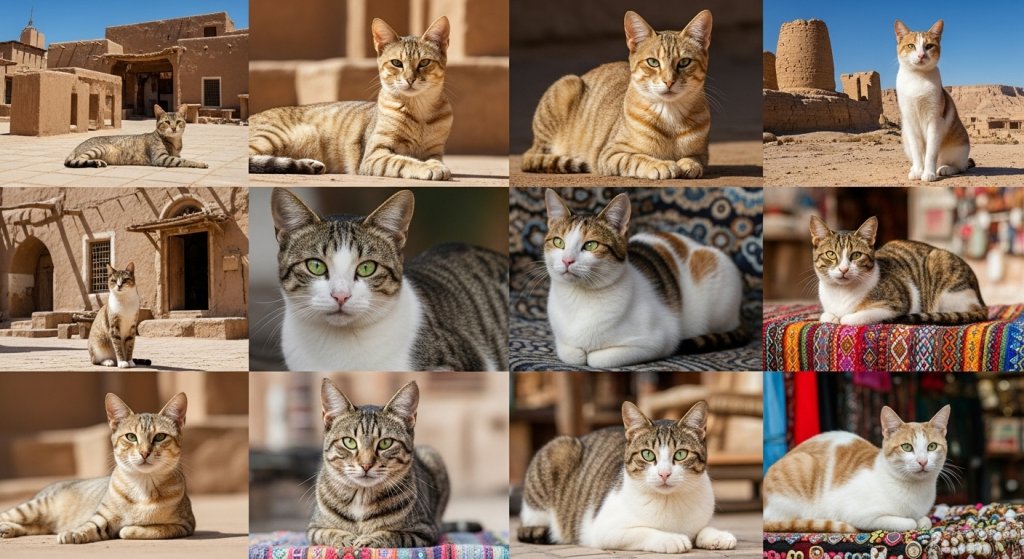The middle eastern cat is more than just a pet; it is a symbol of history, culture, and a deep connection to the land. From the domesticated cats in ancient Egypt to the wild species that still roam the deserts, middle eastern cats have fascinating stories. This article will explore some of the most famous middle eastern cat breeds and the wild felines that share their homeland.
Middle Eastern Cats: History and Cultural Significance
Cats have held a special place in Middle Eastern culture for thousands of years. The History and Cultural Significance of Egyptian Cat Breeds dates back to ancient Egypt, where people revered cats as gods and symbols of protection. They protected homes from pests, and many drawings and hieroglyphs show heavily spotted cats that look just like some of today’s breeds. This close relationship with humans, which began in the Middle East, is one of the reasons cats became a beloved companion animal worldwide.
Fascinating Egyptian Cat Breeds
Several modern breeds trace their roots to the ancient Middle East, particularly Egypt. These fascinating Egyptian cat breeds carry the grace and elegance of their ancestors.
- Egyptian Mau: This medium-sized cat has a short, spotted coat. It is known for its playful and loyal personality, and it is one of the few naturally spotted domestic cat breeds. We also know the breed for its natural spots and “mascara” lines on its face, which you can see in ancient Egyptian art.
- Chausie: People created the Chausie hybrid breed by crossing a domestic cat with a wild jungle cat. Ancient Egyptians respected the wild jungle cat. Chausies are large, affectionate, and playful cats that require a lot of activity and a dedicated owner.
- Abyssinian: One of the oldest breeds in the world. While people still debate its exact origins, it looks a lot like the cats in ancient Egyptian art. Abyssinians are known for their lively and active nature, with a friendly personality and a unique “ticked” coat, which gives it a shimmering appearance.
- Sphynx: Despite its name, which comes from the famous Egyptian monument, the Sphynx cat did not originate in Egypt. This breed, which started in Canada, has a hairless, suede-like coat and a very friendly and energetic personality.
- Savannah: This breed is a hybrid of a domestic cat and a serval, a wild African cat. It is not an Egyptian breed, but its tall, slender body and spotted coat often remind people of the cats in Egyptian art.
The Arabian Mau
The Arabian Mau is a natural breed of middle eastern cats. The History of Arabian Mau dates back over 1,000 years in the deserts of the Arabian Peninsula. These cats are known for their amazing ability to adapt to the harsh desert environment, and they are now a recognized cat breed.
- Physical Traits: Arabian Maus are medium-sized cats with large ears and a short coat that has no undercoat. This helps them stay cool in the hot weather. Their bodies are strong and muscular, and we know them for their graceful movement.
- Temperament: We know them for being very social, intelligent, and affectionate with humans. Because of their history as street cats, they are also very independent and confident.
- Grooming of Arabian Mau: The Arabian Mau is a very low-maintenance cat. Its short fur requires very little brushing, and it is not a heavy shedder. They groom themselves well, making them an easy pet to care for.
Wild Cats of the Middle East
The Middle East is also home to many wild cat species. These middle east wild cat species are often elusive but are a vital part of the region’s wildlife.
- Jungle Cat: A small wildcat that lives in semi-deserts and dry woodlands across the Middle East. It is a powerful hunter, despite its size, and ancient Egyptians respected it.
- Sand Cat: A small, elusive cat with sandy-colored fur that lives in the desert. It is the only cat species that lives in a true desert environment, and it is perfectly adapted to the sand.
- Arabian Caracal: A small wildcat also known as the desert lynx. It is famous for its large ears with long tufts of hair on the tips. It is the smallest of the caracal species and lives in semi-deserts and dry woodlands.
- Caucasian Lynx: A subspecies of the Eurasian lynx, this big cat lives in the mountainous regions of the Middle East.
- Persian Leopard: A large leopard found in the mountains and forests of Iran and other parts of the Middle East. It is a critically endangered big cat.
- Asiatic Cheetah: People also know this critically endangered cheetah as the Persian or Iranian cheetah. You can only find it in Iran.
- Arabian Leopard: Another critically endangered big cat that lives in the mountains of the Arabian Peninsula. Fewer than 200 remain in the wild, which makes its conservation very important.
- Wildcat: The Asiatic wildcat, a subspecies of the wildcat, is also native to the Middle East. It is a small wildcat that lives in a variety of habitats.
Conclusion
Middle eastern cats have a long and fascinating history and cultural significance. From the iconic spotted coats of the Egyptian Mau to the wild felines of the desert, they are a powerful symbol of the region. Learning about these cats is not only a great way to learn about the animals, but also to understand the deep cultural roots they share with the Arab world.
To continue your journey into the richness of the Arabic language and its cultures, consider using the Kaleela app. It provides comprehensive lessons on Modern Standard Arabic and various dialects, helping you master not just the words but also the traditions behind them.



